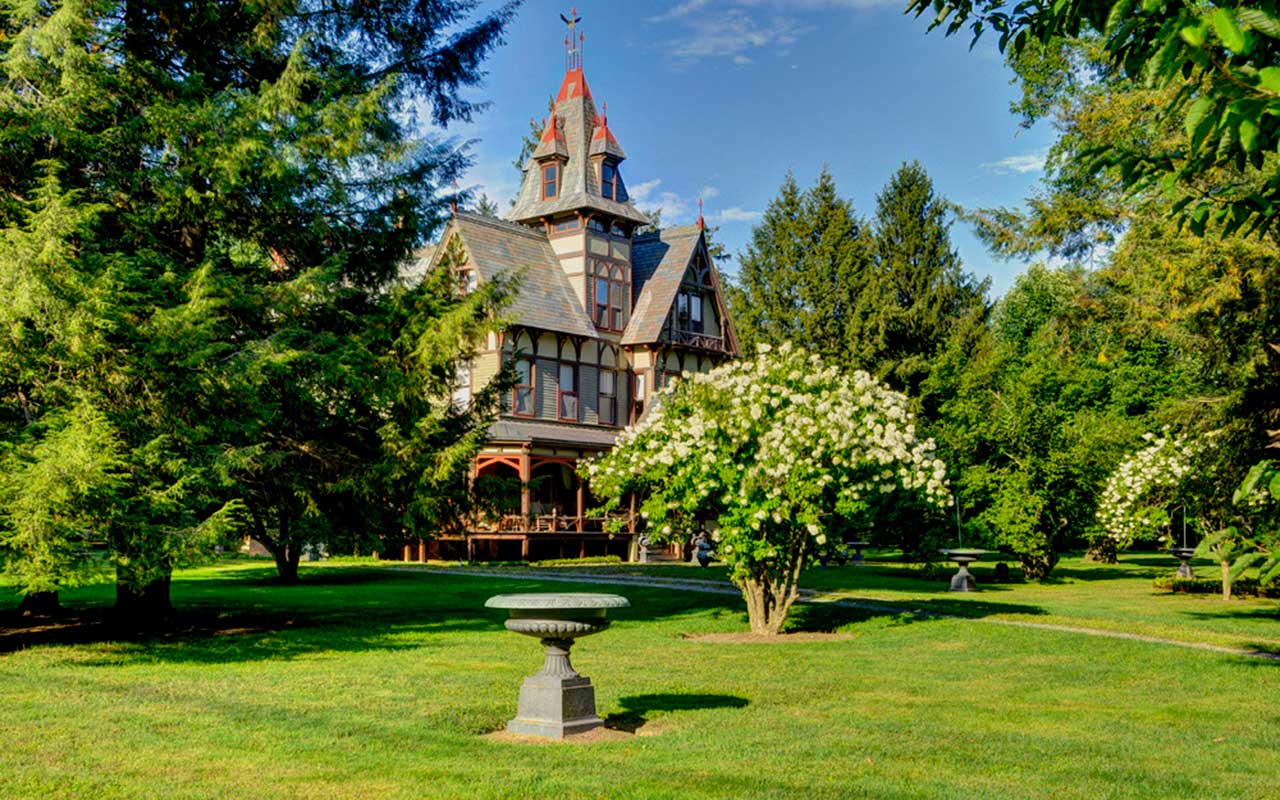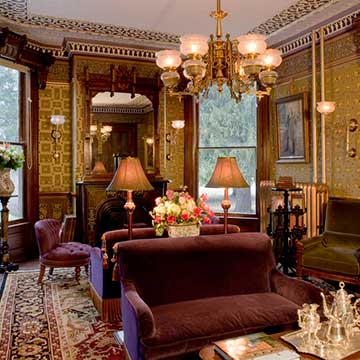This Month’s Featured Article

The Pines – A Victorian Mansion Frozen in Time
 When I take a left turn onto Maple Street, I am admittedly unsuspecting. I’ve seen dazzling pictures of the glorious mansion where Jorge and Eileen Yajure operate The Pines, and I’m confident these photos capture the beauty of the place quite accurately. But the residences and businesses I pass by on my drive through Pine Plains are what I’m used to seeing, so I am in awe when I pull into the driveway of the grounds. Tucked away in the trees, the mansion sits resolutely, a magnificent relic from another time. And time has passed, indeed; built in 1878, The Pines has seen a range of generations, owners, and uses, all while maintaining a look and feel distinct to the era it was constructed. I spoke with owner Jorge Yajure to find out more about the rich history of the property, its influence on the community throughout the years, and what The Pines offers today.
When I take a left turn onto Maple Street, I am admittedly unsuspecting. I’ve seen dazzling pictures of the glorious mansion where Jorge and Eileen Yajure operate The Pines, and I’m confident these photos capture the beauty of the place quite accurately. But the residences and businesses I pass by on my drive through Pine Plains are what I’m used to seeing, so I am in awe when I pull into the driveway of the grounds. Tucked away in the trees, the mansion sits resolutely, a magnificent relic from another time. And time has passed, indeed; built in 1878, The Pines has seen a range of generations, owners, and uses, all while maintaining a look and feel distinct to the era it was constructed. I spoke with owner Jorge Yajure to find out more about the rich history of the property, its influence on the community throughout the years, and what The Pines offers today.
Rebuilding after the fire, in a new style
Sitting on the porch of the house – what property manager Lisa Zayas tells me they call the “outdoor living room” – we begin with Jorge explaining that the current house’s life began on the foundation of the house before it. Through original documentation he acquired from The Poughkeepsie Journal, Jorge learned that in 1877, the previous house caught fire in the early morning. This was discovered when the man extinguishing the corner gas streetlight observed a plume of smoke coming from the top of the house, giving him a chance to wake up the house’s residents so they could flee. “They only escaped with the clothes on their backs. They couldn’t save anything else in the house, and eventually, the house burned to the ground.”
Jorge notes that those who have seen photographs of the original 1830s Greek revival-style structure remark that it was fit with colonnades and a White House resemblance; this house, built by William Eno, posed a sharp juxtaposition to the style of mansion we see today, which was built by his son William Stewart Eno. The Poughkeepsie Journal continued to chronicle happenings at the property after the fire, from the demolishing to the rebuilding to the interior designing of the new house. “They also wrote about when he [owner William Stewart Eno] notified the town that he was done, his house was ready, and he invited friends and family to come and look at his new house. And apparently, that was one calendar year from the time it burnt down, which is an amazing thing to think about, between the type of architecture that it is, the massing of it, and also the location in the countryside.” Scarcity of labor and materials, paired with three months of winter, Jorge says, makes their quick completion of the process in 1878 “a tremendous feat.”
With modifications to accommodate the new architecture, the foundation was ready for a style more typical of the late 1800s. Jorge explains, “That style of architecture was in vogue at that time. It is called the ‘Swiss Chalet,’ or ‘Stick Style’ in America, because of the way the exterior framing of the house is exposed, not under the skin of the house.” It’s been pointed out that the house bears a striking resemblance to Wilderstein Historic Site in Rhinebeck. Because there are no records indicating the designer of The Pines, Jorge adds, “those ‘in the know’ feel that some of the architectural features are too similar to Wilderstein not to be related.”
A meticulously detailed pen rendering of the property from the perspective of North Main, now Maple Street, illustrates what the mansion and grounds initially looked like. This drawing was created for an 1882 book History of Duchess County, New York, which at the time served as a “who’s who in the county.” According to Jorge, getting featured in such a book, and subsequently earning societal recognition, likely required some form of payment. “The person who did the rendering went through painstaking details to portray what was here, including the outbuildings (of which there weren’t that many).” Jorge adds that, excepting the outer fence that is no longer surrounds the perimeter, “every architectural detail of the house that was in the rendering is still here today.”
William Stewart Eno and the Eno family’s impact
William Stewart Eno’s care for societal standing and tendency to associate with highly powerful industry figures in New York City had a pivotal impact on Pine Plains. His connections played a central role in bringing key transportation infrastructure to the town. “It is said that he was instrumental in convincing the railroad executives to lay tracks and actually put a train station here in town, which eventually happened,” Jorge describes. “Like today, there were a lot of farms that wanted to have their products accessible other cities here in the county and to bigger markets like New York City. So, the fact that a train station was built, and train tracks were laid – I mean that was a very costly endeavor, to lay tracks and invest in infrastructure so that trains can service your town and your area.”
Jorge recalls hearing about a time when up to 18 trains would come to Pine Plains in one day, undoubtedly boosting commerce in the area. These would arrive from the city or cross the town from Poughkeepsie en route to Connecticut or Massachusetts. “Even if it didn’t increase the size of the town, which would have been the normal path of the community upon such an influx of infrastructure, at least people were able to come to Pine Plains, and the local businesses could make their products available.”
After making an impact on the community in this way, and eventually serving as president of the Stissing National Bank, William Stewart Eno and his family moved to Philadelphia in the 1890s after about 20 years in the house. His investment company, Bunnell and Eno Investments, had moved its offices from Pine Plains to New York City to Philadelphia, and by that point had acquired a high-profile board of directors charged with funding projects in the West. However, this whole enterprise was a Ponzi scheme. Jorge continues, “There are accounts that a group of investors got worried that they could not withdraw their investments out of the fund easily, and many of them traveled to Philadelphia to inquire as to the reasons for the fund’s resistance. Legend has it that one of those meetings in 1902 got overheated, and William suffered a stroke and died in his office.”
The succession of ownership… and a little folklore
In the wake of William Stewart Eno’s death and the scandal, which got days of press in The New York Times, his assets were sorted by the courts over the course of two years. However, when it finally came time to sell the mansion, people were not so quick to bite. “In 1904, I am told, the house went up for auction and nobody bid on it,” Jorge says. It wasn’t until a man named Dr. Smith purchased the residence that it fell into new hands. He ran his practice on the first floor, while living with his family on the second and third floors, for what Jorge estimates was five to ten years. In any case, Jorge points out, it was long enough that Dr. Smith had postcards made depicting the house as his residence.
Following the doctor’s tenure, a German couple, the Deppes, purchased the property shortly after arriving in the United States. “Obviously, they were young when they bought The Pines. But nobody knew, and nobody can explain, how they were able to afford the grandest house in the town when they had just arrived and had no money.” According to Jorge, the couple ran The Pines, renting rooms and boarding people – albeit frugally – for around 60 years. “We believe that is the reason that the house preserved a lot of its historical character, because they couldn’t afford to do anything with the house. They couldn’t modernize, they couldn’t add, they couldn’t upgrade systems, or decorate for the fashion of the day.”
Surprisingly, it was during this period of ownership that Eileen Yajure’s great aunt actually visited the property. “Later on, when she came to live with us during her senior years, she remembered, ‘I know this house. I’ve been here,’” Jorge says. Eileen’s great aunt recounted driving up from Yonkers with her husband for a weekend trip, and ending up at the mansion. Details she recollected have since been corroborated by descendents of the Deppe family, with her descriptions matching up with individuals like Mrs. Deppe and a young man that helped her at The Pines. Jorge exclaims, “It’s such a small world!”
While purely hearsay, it has been suggested that New York City mafia boss Dutch Schultz was the reason the Deppes were able to purchase the property in the first place. “It is documented that Dutch Schultz had farms here in town,” Jorge notes. He recalls hearing that at the height of Prohibition, one of Schultz’s farms in the area, which operated as a bootleg distillery, was famously raided by the federal government. “People put two and two together,” Jorge explains. “There’s no physical documentation that he was ever here, it’s just an assumption that if he had businesses here, he probably came up to see them. And he was German, of German Jewish descent, and the couple here were German, so people kind of went, ‘Well, I’m sure there was some connection there. Somebody was financing them behind the scenes.’”
Following the death of her husband and after acquiring a house across the street, Mrs. Deppe sold the property to its next owners, Bruce and Stella Palmer, in the 1970s. Not only did the Palmers get The Pines listed onto the National Register of Historic Places, but they also gave the house a new slate roof. “Fortunately, the house fell in the hands of preservationists that appreciated the building for its historical fiber,” Jorge recounts.
After a few years, they sold the house to Dale and Lorna Mitchell, who for the next 15-20 years would run The Pines as a bed and breakfast. Then, in 2002, Jorge and Eileen Yajure purchased the property.
The Pines today
Before buying the mansion, Jorge and Eileen had tried to launch a bed and breakfast in Peekskill at a smaller multi-family residential property similar to The Pines, which they planned to remodel. Along with this, after seven years, they were able to successfully implement a historical society in Peekskill and looked to effect more change by running for local office. When Eileen’s mayoral prospects in town fell through after a close electoral race, they made the decision to relocate following a trip to the Tuscany region of Italy. “We came back here, and we said, ‘Let’s go up to the country,’ on a Saturday or Sunday. We got into Dutchess County, and we started looking at the topography of the area. We were like, ‘Wow. This place has no reason to envy Tuscany.’ The geography is so beautiful. The farms are so beautiful.”
After discovering The Pines in a real estate magazine and winning the bidding war on the property, the couple made the move, selling their two properties in Peekskill. Both students of Victorian interiors and culture, Jorge and Eileen ended up making quite the fitting decision when they first put a down payment on The Pines.
Upon purchasing the house, the Yajures were tasked with a number of repair projects. They had to restore the porches, front portico, and paint job – this especially required highly careful attention, as the mansion had accumulated 40 layers of lead paint, which needed to be replaced all the way up to the building’s 80-foot tower. The couple’s initial plans were to maintain The Pines as a bed and breakfast and boutique hotel where families could spend the weekend and soak in the style of the Gilded Age in a unique experience. This was especially important to Jorge and Eileen because many of the historic houses they had visited did not allow the immersion of exploring the inside of the property, let alone staying there overnight.
About six or seven years ago, they transitioned the mansion into a self-catering property, renting out The Pines for weekends, vacations, and special events like family reunions and weddings. Notably, the house has been featured in movies; scenes in the 2018 film Furlough take place in the mansion. It has also been used as a location for numerous photo shoots.
Jorge and Eileen’s ultimate goal in this whole process has been to balance period-style decor and comfort to ensure that the nostalgic, historical value of The Pines shines through. Now that I have seen the mansion and learned all about its vibrant past, I can confidently say that they have succeeded in this aim. •
To book a stay at The Pines, you can find the property listed on Vrbo at vrbo.com/782817. You can contact The Pines property manager Lisa Zayas at (570) 269-5649 or send The Pines an email at jyajure@FTRcpm.com. To visit their website and see more photos of the property, go to thepines1878.com.



